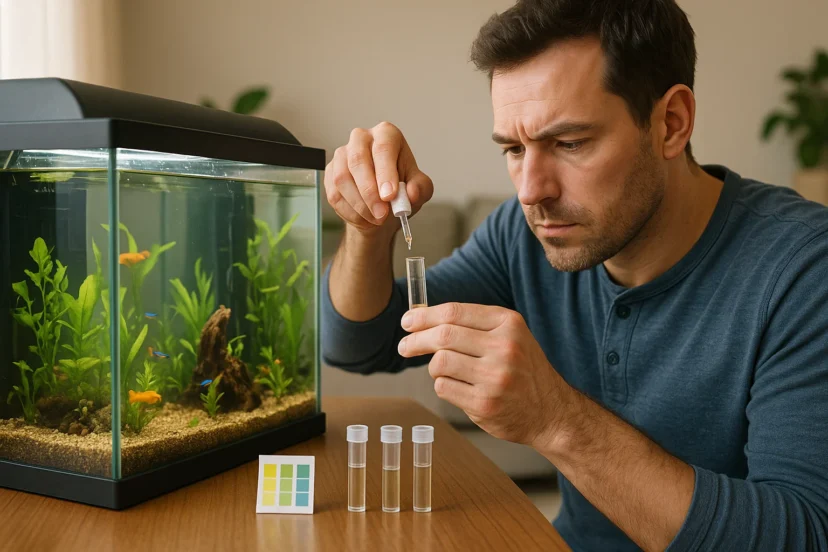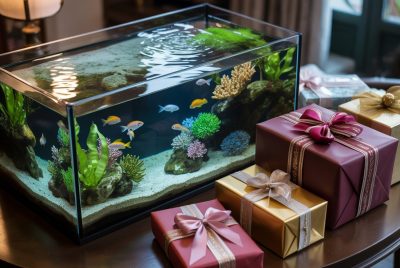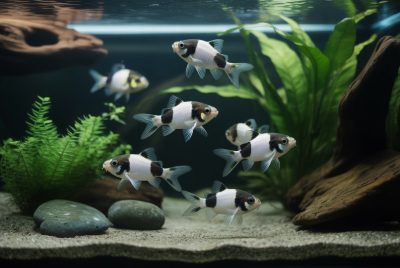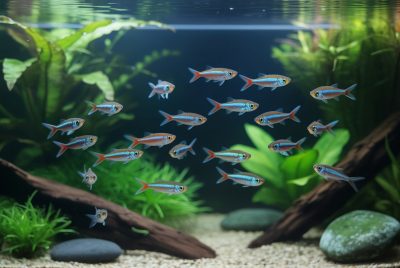Ideal Water Parameters for Freshwater Fish
*We may earn a commission for purchases made using our links. Please see our disclosure to learn more.
The difference between a thriving aquarium and a constant struggle often comes down to something invisible to the naked eye: water chemistry. While crystal-clear water might appear perfect, the unseen chemical composition determines whether fish flourish or merely survive in their aquatic environment.
Water parameters represent the hidden foundation of aquarium success, influencing everything from fish behavior and coloration to immune system function and reproductive health. These measurable factors—including pH levels, temperature, ammonia content, and mineral concentrations—create the difference between fish that display vibrant colors and natural behaviors versus those that appear stressed, dull, or constantly battle health issues.
Most aquarium failures stem not from inadequate equipment or poor fish selection, but from misunderstood water chemistry that gradually undermines fish health over time. Even experienced aquarists sometimes overlook the critical relationship between stable water parameters and long-term success, focusing instead on visible aspects like filtration systems or decorative elements.
Professional aquarium management and fish breeding operations prioritize water parameter control above all other factors because they understand a fundamental truth: fish cannot adapt to constantly changing chemical conditions, regardless of how expensive the equipment or how carefully they’re fed. Consistency in water chemistry creates the stable environment that allows fish to thrive rather than simply survive.
This comprehensive guide demystifies freshwater aquarium water chemistry, transforming complex concepts into practical knowledge that any aquarium enthusiast can apply. Understanding these principles will shift your aquarium management from reactive problem-solving to proactive environmental control, creating conditions where freshwater fish can display their full potential.
“The secret to a thriving aquarium isn’t perfect water—it’s stable water. Fish can adapt to a wide range of conditions, but they cannot adapt to constantly changing conditions.”
– Dr. Timothy Hovanec, Aquarium Microbiologist and Water Chemistry Expert
Key Takeaways
- pH levels should remain stable between 6.5-7.5 for most freshwater fish, with species-specific variations requiring careful research
- Temperature consistency matters more than exact degrees – maintain stable temperatures within each species’ preferred range
- The nitrogen cycle is non-negotiable – ammonia and nitrite must remain at zero, while nitrates should stay below 20 ppm
- Water hardness affects fish physiology – match GH and KH levels to your fish species’ natural habitat requirements
- Regular testing prevents problems – weekly parameter checks catch issues before they become fish health crises
- Gradual changes protect fish – sudden parameter shifts cause more stress than slightly imperfect conditions
Understanding the Foundation: Why Water Parameters Matter
The relationship between water quality and fish health operates on a cellular level that many aquarium enthusiasts never fully grasp. Fish don’t simply swim in water—they live completely immersed in their environment, breathing it, absorbing nutrients through it, and eliminating waste into it. Every parameter affects their biological processes, from oxygen absorption through their gills to the function of their internal organs.
When water parameters drift outside acceptable ranges, fish experience physiological stress that manifests in various ways. Behavioral changes often appear first: decreased appetite, unusual swimming patterns, gasping at the surface, or hiding more frequently than normal. Physical symptoms follow, including damaged fins, unusual coloring, labored breathing, or increased susceptibility to diseases that healthy fish would naturally resist.
The interconnected nature of aquarium water chemistry means that one parameter rarely shifts in isolation. pH changes affect ammonia toxicity levels, temperature fluctuations influence oxygen solubility, and hardness variations impact a fish’s ability to regulate internal salt concentrations. Understanding these relationships transforms aquarium maintenance from reactive problem-solving to proactive environmental management.
The Critical Seven: Essential Water Parameters
pH Levels: The Acidity-Alkalinity Balance
pH measures water’s acidity or alkalinity on a scale from 0 to 14, with 7.0 representing neutral conditions. Most freshwater fish thrive in slightly acidic to neutral water, typically between 6.5 and 7.5, though specific species have evolved to prefer different ranges.
The stability of pH levels often matters more than achieving a perfect number. Fish adapt remarkably well to consistent conditions slightly outside their ideal range, but rapid pH swings cause immediate stress and potential tissue damage. Factors affecting pH include biological processes within the tank, substrate materials, decorations, and the source water’s natural chemistry.
Maintaining stable pH requires understanding your aquarium’s buffering capacity, primarily determined by carbonate hardness (KH). Higher KH levels resist pH changes, while lower KH allows more dramatic fluctuations. Regular monitoring helps identify trends before they become problematic, allowing for gradual adjustments that fish can accommodate comfortably.
Temperature: The Metabolic Regulator
Water temperature directly controls fish metabolism, affecting everything from digestion and growth rates to immune system function and reproductive behaviors. Each species has evolved within specific temperature ranges that optimize their biological processes, making temperature management crucial for long-term health.
Tropical freshwater fish generally require temperatures between 72-78°F (22-26°C), while temperate species prefer cooler conditions around 65-72°F (18-22°C). However, these ranges represent general guidelines—research specific requirements for each species in your aquarium to ensure optimal conditions.
Temperature stability proves more critical than exact degrees. Daily fluctuations exceeding 2-3°F can stress fish, while rapid changes of 5°F or more can shock their systems and compromise immune function. Quality aquarium heaters with reliable thermostats, combined with accurate thermometers, provide the consistency fish require for optimal health.
The Nitrogen Cycle: Life and Death Chemistry
The nitrogen cycle represents the most critical biological process in any aquarium, converting toxic waste products into less harmful compounds through beneficial bacteria colonies. Understanding this cycle means grasping the difference between a thriving aquarium and a toxic environment that slowly poisons its inhabitants.
Ammonia (NH3/NH4+) enters the system through fish waste, uneaten food, and decomposing organic matter. Even low concentrations prove toxic to fish, causing gill damage, stress, and eventual death if left unchecked. In healthy aquariums, Nitrosomonas bacteria convert ammonia into nitrite (NO2-), which remains highly toxic but represents progress in the nitrogen cycle.
Nitrobacter bacteria then convert nitrite into nitrate (NO3-), which fish tolerate in moderate concentrations. While nitrates are less immediately dangerous, accumulation above 20 ppm can cause long-term health problems and encourage unwanted algae growth. Regular water changes remove nitrates, completing the cycle and maintaining water quality.
Establishing robust bacterial colonies requires patience, typically taking 4-6 weeks in new aquariums. During this cycling period, ammonia and nitrite levels spike before stabilizing as bacterial populations mature. Testing throughout this process ensures fish aren’t added before the system can safely process their waste.
Water Hardness: Mineral Content and Fish Physiology
Water hardness measures dissolved mineral concentrations, primarily calcium and magnesium compounds that affect fish physiology in subtle but important ways. Two measurements define hardness: General Hardness (GH) indicates total dissolved minerals, while Carbonate Hardness (KH) measures buffering capacity against pH changes.
Fish species evolved in waters with specific mineral profiles, developing internal regulatory systems optimized for those conditions. Soft water species, like many tetras and rasboras, struggle in hard water environments where excess minerals disrupt their osmoregulation. Conversely, cichlids from mineral-rich lakes require harder water to maintain proper internal salt balances.
GH levels typically range from 3-12 dGH for most freshwater fish, while KH levels between 3-8 dKH provide adequate buffering. However, these ranges vary significantly based on species origins. Research your fish’s natural habitat conditions to determine appropriate hardness levels for optimal health and longevity.
Species-Specific Considerations: Tailoring Parameters to Fish Needs
Community Tank Compromises
Creating optimal conditions in community tanks requires balancing different species’ requirements, often necessitating compromises that keep all fish healthy without perfectly suiting any single species. Successful community tanks focus on compatible species with overlapping parameter preferences rather than forcing incompatible fish to coexist.
Most peaceful community fish tolerate pH levels between 6.8-7.2, temperatures around 75-77°F, and moderate hardness levels. These “middle ground” conditions accommodate tetras, rasboras, corydoras, and many other popular species while avoiding extremes that stress sensitive fish.
However, some species simply cannot compromise on specific parameters. African cichlids require alkaline, hard water that would stress soft water species, while discus need very soft, acidic conditions that many community fish cannot tolerate. Researching compatibility before purchasing prevents future problems and ensures long-term success.
Specialized Species Requirements
Certain fish species have evolved in unique environments that require specific parameter management for optimal health. Understanding these special requirements helps decide whether particular species fit your aquarium goals and maintenance capabilities.
Discus, often called the “king of aquarium fish,” require very soft water (1-4 dGH) with acidic pH (6.0-6.5) and elevated temperatures (82-86°F). These demanding conditions reflect their Amazonian origins, where they evolved in mineral-poor, tannin-stained waters with naturally high temperatures.
African Rift Lake cichlids present opposite requirements, needing hard, alkaline water (12-20 dGH, pH 7.8-8.6) that mimics their natural lake environments. Attempting to keep these species in soft, acidic water leads to stress, poor coloration, and increased disease susceptibility.
Goldfish, despite their reputation as “easy” fish, prefer cooler temperatures (65-72°F) and can tolerate a wide pH range but require excellent water quality due to their high waste production. Their cold-water preferences make them incompatible with tropical species, despite many beginners attempting this combination.
Testing and Monitoring: The Foundation of Success
Establishing Testing Routines
Consistent water testing provides early warning of parameter shifts before they endanger fish health. Establishing regular testing schedules ensures problems are caught and corrected during their early stages when solutions remain simple and stress-free for fish.
Weekly testing of pH, ammonia, nitrite, and nitrate levels provides adequate monitoring for established aquariums with stable bioloads. New aquariums require daily testing during the cycling process, while tanks with recent changes (new fish, medication treatments, equipment failures) benefit from increased testing frequency until stability returns.
Temperature monitoring should occur daily, either through continuous digital displays or quick visual checks of thermometers. Temperature fluctuations often indicate equipment problems that require immediate attention to prevent fish stress or equipment failure.
Interpreting Test Results
Understanding test results requires more than reading numbers—it involves recognizing trends, understanding acceptable ranges for your specific fish, and knowing when immediate action is necessary versus when gradual adjustments are appropriate.
Zero readings for ammonia and nitrite are always the goal in established aquariums. Any detectable levels indicate problems with the biological filtration system, overstocking, overfeeding, or inadequate maintenance. Immediate water changes and investigation of the underlying cause prevent fish health problems.
Nitrate levels below 20 ppm indicate good water quality maintenance, while levels between 20-40 ppm suggest more frequent water changes are needed. Nitrate levels above 40 ppm require immediate large water changes and evaluation of feeding practices, stocking levels, and maintenance schedules.
pH readings require interpretation based on your fish species’ preferences and the water’s buffering capacity. Stable pH slightly outside ideal ranges causes less stress than fluctuating pH within “perfect” ranges. If adjustments are necessary, make them gradually over several days to prevent shocking fish systems.
Common Challenges and Solutions
Dealing with Parameter Fluctuations
Even well-maintained aquariums experience occasional parameter fluctuations due to various factors including seasonal water supply changes, equipment malfunctions, maintenance oversights, or biological disruptions within the tank ecosystem.
pH crashes often occur in aquariums with insufficient buffering capacity, particularly those with low KH levels. Decomposing organic matter produces acids that overwhelm the water’s natural buffering, causing rapid pH drops that stress fish. Increasing KH through water changes or buffer additives prevents future crashes while supporting beneficial bacteria colonies.
Temperature fluctuations usually indicate heater problems, inadequate heating capacity for the tank size, or placement in areas subject to environmental temperature changes. Installing backup heaters, using heater controllers, and monitoring ambient room temperatures help maintain stability.
Ammonia spikes in established tanks typically result from biological filter disruption, whether through aggressive cleaning, medication treatments, or bacterial die-offs caused by power outages. Immediate water changes reduce toxicity while beneficial bacteria populations recover, usually requiring 1-2 weeks for full restoration.
Addressing Overcrowding and Bioload Issues
Overcrowding represents one of the most common causes of parameter instability, as too many fish produce waste faster than the biological filtration system can process it safely. Recognizing overcrowding symptoms and implementing solutions protects fish health while restoring water quality.
Signs of overcrowding include persistent nitrate elevation despite regular water changes, frequent ammonia or nitrite detection, fish displaying stress behaviors, increased aggression due to territorial pressure, and difficulty maintaining stable parameters despite proper maintenance.
Solutions involve either reducing fish numbers through rehoming or significantly increasing filtration capacity and maintenance frequency. Additional biological filtration, more frequent water changes, and reduced feeding can help manage higher bioloads, but long-term success often requires reducing stocking levels to sustainable numbers.
Managing Seasonal and Environmental Changes
External factors beyond direct aquarium control can influence water parameters, requiring adaptive management strategies that maintain stability despite changing conditions. Understanding these influences helps prevent problems before they affect fish health.
Municipal water supplies often change seasonally as treatment facilities adjust for different source water conditions. Regular testing of tap water used for changes helps identify when parameter adjustments are necessary to maintain aquarium stability.
Seasonal temperature changes affect both room temperature and the performance of aquarium equipment. Heaters may struggle during winter months, while summer heat can elevate temperatures beyond safe ranges. Monitoring and adjusting equipment settings seasonally prevents temperature-related stress.
Advanced Parameter Management
Understanding Buffer Systems
Buffer systems maintain pH stability by neutralizing acids and bases before they can cause dramatic parameter shifts. Natural buffer systems in aquariums include carbonate hardness, which provides primary pH buffering, and various biological processes that help maintain chemical equilibrium.
Carbonate hardness (KH) acts as the primary buffer against pH changes, with higher KH levels providing greater stability. However, very high KH can make intentional pH adjustments difficult, while very low KH allows rapid pH swings that stress fish. Most freshwater aquariums benefit from KH levels between 3-8 dKH.
Biological buffering occurs through natural processes including bacterial activity, plant photosynthesis and respiration, and fish metabolism. Understanding these natural systems helps aquarium keepers work with biological processes rather than against them, creating more stable, self-regulating environments.
Water Change Strategies
Water changes serve multiple functions beyond parameter maintenance, including removing dissolved organic compounds, replenishing trace elements, and diluting accumulated toxins that standard filtration cannot address. Developing effective water change strategies optimizes these benefits while minimizing fish stress.
Frequency and volume of water changes depend on tank bioload, filtration efficiency, and specific fish requirements. Lightly stocked tanks with excellent filtration may thrive with 20% weekly changes, while heavily stocked or sensitive species may require 25-30% changes twice weekly.
Temperature matching prevents thermal shock during water changes, while chlorine/chloramine treatment ensures new water won’t harm fish or beneficial bacteria. Gradual water addition reduces current disturbance and allows fish to adjust to any minor parameter differences between old and new water.
Troubleshooting Persistent Problems
Some parameter issues resist standard solutions, requiring systematic troubleshooting to identify underlying causes and implement effective corrections. Persistent problems often involve multiple contributing factors that must be addressed comprehensively.
Chronic pH instability despite adequate KH levels may indicate substrate materials, decorations, or biological processes that consume buffering capacity faster than it can be replenished. Identifying and removing pH-affecting materials or increasing buffer replacement through more frequent water changes often resolves these issues.
Recurring ammonia or nitrite spikes in established tanks suggest biological filtration problems that require investigation beyond simple water changes. Potential causes include inadequate beneficial bacteria populations, filter media problems, medication residues that inhibit bacterial function, or bioload exceeding system capacity.
Creating Long-Term Success
Developing Maintenance Routines
Successful aquarium keeping relies on consistent maintenance routines that prevent problems rather than reacting to crises. Developing sustainable schedules that fit your lifestyle ensures long-term success without becoming overwhelming burdens.
Daily tasks include feeding appropriate amounts, observing fish behavior and health, checking equipment function, and noting any changes in water appearance or odor. These quick observations often catch problems early when solutions remain simple.
Weekly maintenance typically includes water testing, partial water changes, algae removal, and equipment cleaning. Monthly deep cleaning addresses filter media replacement, gravel vacuuming, and plant maintenance as needed.
Planning for Fish Additions
Adding new fish to established aquariums requires careful planning to maintain parameter stability while ensuring compatibility between existing and incoming species. Proper quarantine procedures and gradual introduction prevent disease outbreaks and minimize stress on all tank inhabitants.
Quarantine periods lasting 2-4 weeks allow observation of new fish health while preventing disease transmission to established populations. During quarantine, maintain similar water parameters to the main tank while monitoring for signs of illness or stress.
Gradual introduction begins with floating sealed bags containing new fish in the main tank, allowing temperature equalization over 15-20 minutes. Slowly mixing tank water with bag water over another 15-20 minutes helps fish adjust to any parameter differences before release.
Environmental Enrichment and Parameter Stability
Natural Approaches to Water Quality
Incorporating natural elements that support water quality creates more stable, self-regulating aquarium environments while providing aesthetic and behavioral benefits for fish. Understanding how plants, substrate, and biological processes interact helps create balanced ecosystems.
Live plants consume nitrates while producing oxygen during photosynthesis, helping maintain water quality while creating natural environments that reduce fish stress. However, plant respiration at night consumes oxygen and produces CO2, which can affect pH in heavily planted tanks.
Natural substrate materials like sand or fine gravel support beneficial bacteria colonies while allowing natural foraging behaviors. Avoiding chemically active substrates prevents unwanted parameter changes while maintaining biological filtration efficiency.
Driftwood and natural decorations provide hiding places that reduce stress while slowly releasing tannins that can naturally acidify water. While some fish species benefit from tannin-stained water, others may be stressed by pH changes, requiring careful monitoring during initial introduction.
Biological Balance and Fish Behavior
Maintaining optimal water parameters supports natural fish behaviors that indicate healthy, unstressed animals. Understanding the connection between water quality and behavior helps assess tank conditions beyond numerical test results.
Healthy fish display natural behaviors including active swimming, normal feeding responses, bright coloration, and species-appropriate social interactions. Deviations from normal behavior often indicate parameter problems before test kits detect measurable changes.
Stress behaviors include hiding, refusing food, gasping at the surface, clamped fins, or unusual aggression. These behavioral changes often precede physical symptoms and provide early warning of parameter problems that require investigation and correction.
Social dynamics within the aquarium can also indicate parameter stress, as compromised fish become more susceptible to aggression from tankmates or may become more aggressive themselves due to physiological stress.
Conclusion
Mastering ideal water parameters for freshwater fish transforms aquarium keeping from a constant struggle into a rewarding hobby where fish thrive and display their natural beauty. The investment in understanding water chemistry, establishing testing routines, and maintaining parameter stability pays dividends in fish health, longevity, and the pure joy of observing healthy aquatic life.
Remember that parameter perfection isn’t always achievable or necessary—consistency and gradual adjustments create better outcomes than chasing exact numbers through rapid changes that stress fish. Each aquarium develops its own biological balance that, once established and maintained, provides stable conditions with minimal intervention.
The journey toward water parameter mastery requires patience, observation, and willingness to learn from both successes and setbacks. Every aquarium teaches valuable lessons about water chemistry, fish behavior, and the delicate balance that sustains aquatic life. Embrace the learning process, celebrate improvements, and remember that even experienced aquarists continue discovering new aspects of water management throughout their hobby journey.
Your commitment to understanding and maintaining proper water parameters creates an environment where freshwater fish can live their best possible lives, displaying natural behaviors, vibrant colors, and the peaceful presence that makes aquarium keeping such a rewarding pursuit. The knowledge and skills developed through parameter management extend beyond single tanks, creating expertise that enhances every future aquatic project and contributes to the broader aquarium keeping community’s success.
Frequently Asked Questions
Q: How often should I test water parameters in my freshwater aquarium?
A: For established aquariums, weekly testing of pH, ammonia, nitrite, and nitrate provides adequate monitoring. New tanks require daily testing during the 4-6 week cycling period, while tanks experiencing changes (new fish, medications, equipment issues) benefit from increased testing frequency until stability returns. Temperature should be monitored daily through visual thermometer checks.
Q: What should I do if my pH keeps fluctuating despite regular maintenance?
A: pH fluctuations usually indicate insufficient buffering capacity (low KH) or materials in the tank that affect pH stability. Test and increase KH levels through water changes or buffer additives, remove any limestone, shells, or driftwood that might be altering pH, and ensure adequate biological filtration to prevent organic acid buildup from decomposing waste.
Q: Can I keep different fish species together if they have different ideal water parameters?
A: Yes, but focus on species with overlapping parameter ranges rather than extreme differences. Most community fish tolerate pH 6.8-7.2, temperatures 75-77°F, and moderate hardness levels. Avoid combining species with drastically different needs, such as African cichlids (hard, alkaline water) with discus (soft, acidic water), as compromise conditions stress both species.
Q: How do I fix high nitrate levels that won’t come down with water changes?
A: Persistent high nitrates indicate the tank produces waste faster than your maintenance routine removes it. Increase water change frequency and volume, reduce feeding amounts, check for hidden dead fish or decaying plant matter, vacuum substrate more thoroughly, clean filter media, and consider reducing fish numbers if bioload exceeds system capacity. Live plants can also help consume nitrates naturally.
Q: Is it normal for water parameters to be slightly different from “ideal” ranges?
A: Absolutely. Parameter stability matters more than achieving perfect numbers. Fish adapt well to consistent conditions slightly outside their ideal ranges, but struggle with fluctuating parameters even within “perfect” ranges. Focus on maintaining stable conditions your fish can adapt to rather than constantly adjusting parameters to match textbook ideals, which often causes more stress than slightly imperfect but stable water.




